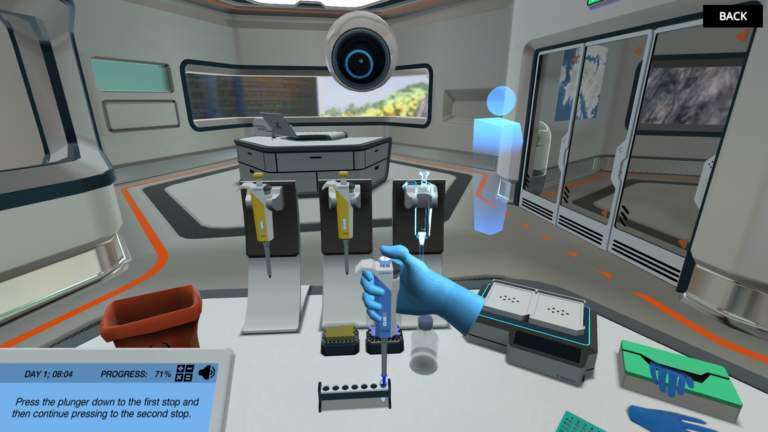Heading 1
Heading 2
Heading 3
Heading 4
Heading 5
Heading 6
Lorem ipsum dolor sit amet, consectetur adipiscing elit, sed do eiusmod tempor incididunt ut labore et dolore magna aliqua. Ut enim ad minim veniam, quis nostrud exercitation ullamco laboris nisi ut aliquip ex ea commodo consequat. Duis aute irure dolor in reprehenderit in voluptate velit esse cillum dolore eu fugiat nulla pariatur.
Block quote
Ordered list
- Item 1
- Item 2
- Item 3
Unordered list
- Item A
- Item B
- Item C
Bold text
Emphasis
Superscript
Subscript
About This Simulation
Learn how to handle micropipettes, which are one of the most important pieces of laboratory equipment. Get ready to show off your pipetting skills for those technical microscale experiments when you enter the lab for the first time.
Learning Objectives
- Explain why micropipettes are used in laboratory settings
- Choose the correct pipettor for a given use case
- Describe to correct use of the two stops on a micropipette plunger
About This Simulation
Lab Techniques
- Pipetting
Related Standards
- Early Stage Bachelors Level
- EHEA First Cycle
- EHEA Short Cycle
- FHEQ 4
- FHEQ 5
- FHEQ 6
- Support for laboratory skills at all levels
- US College Year 2
- US College Year 1
- Generic support for fume hood use, lab safety and good scientific practice
- Generic support for relevant Lab Investigations
- Generic technical support for practical skill development
Learn More About This Simulation
This short, targeted simulation is adapted from the full-length “Pipetting: Master the technique” simulation.
Micropipettes are the extended arms of every aspiring scientist. In this simulation, you will be introduced to the basics of pipetting as you dive right into trying your new skill out in the lab. Step by step, you will learn how to adjust the volume on the P20, P200, and P1000 pipette, use the two ‘stops’ of the plunger and find out which pipette to use for which volume range. You will also learn some tricks about pipetting more accurately in the microliter range. Will you be able to select the correct micropipette when you are given the challenge to do so?
Try out the P1000 Micropipette
After your introduction, you will be able to get hands-on experience with the P1000 micropipette, exploring all its parts and functions. While selecting the right pipette tip to P1000, you will also learn the importance of sterile work. You will get to explore the measuring range of a calibrated P1000 pipette by using the thumbwheel and practice aspirating and dispensing by adding a common buffer to a fresh microcentrifuge tube.
Become a master of pipetting
You will learn about the benefits of microscale experimentation to understand why micropipettes are essential instruments for laboratory work. In our virtual labs, we use air-displacement pipettes that aspirate and dispense liquid samples. For the best pipetting technique, you will first learn about the two stops on the plunger, the measurement ranges of P20, P200, and P1000 pipettes and interpret the volume display of micropipettes. This knowledge is essential if you want to accurately and precisely measure small volumes in a laboratory setting.
Select the correct micropipette Finally, you will be presented with a challenge to choose the correct micropipette for a hypothetical task. Will you be able to decide between the P20, P200, or the P1000 for the most accurate pipetting?
For Science Programs Providing a Learning Advantage
Boost STEM Pass Rates
Boost Learning with Fun
75% of students show high engagement and improved grades with Labster
Discover Simulations That Match Your Syllabus
Easily bolster your learning objectives with relevant, interactive content
Place Students in the Shoes of Real Scientists
Practice a lab procedure or visualize theory through narrative-driven scenarios


FAQs
Find answers to frequently asked questions.
Heading 1
Heading 2
Heading 3
Heading 4
Heading 5
Heading 6
Lorem ipsum dolor sit amet, consectetur adipiscing elit, sed do eiusmod tempor incididunt ut labore et dolore magna aliqua. Ut enim ad minim veniam, quis nostrud exercitation ullamco laboris nisi ut aliquip ex ea commodo consequat. Duis aute irure dolor in reprehenderit in voluptate velit esse cillum dolore eu fugiat nulla pariatur.
Block quote
Ordered list
- Item 1
- Item 2
- Item 3
Unordered list
- Item A
- Item B
- Item C
Bold text
Emphasis
Superscript
Subscript
A Labster virtual lab is an interactive, multimedia assignment that students access right from their computers. Many Labster virtual labs prepare students for success in college by introducing foundational knowledge using multimedia visualizations that make it easier to understand complex concepts. Other Labster virtual labs prepare learners for careers in STEM labs by giving them realistic practice on lab techniques and procedures.
Labster’s virtual lab simulations are created by scientists and designed to maximize engagement and interactivity. Unlike watching a video or reading a textbook, Labster virtual labs are interactive. To make progress, students must think critically and solve a real-world problem. We believe that learning by doing makes STEM stick.
Yes, Labster is compatible with all major LMS (Learning Management Systems) including Blackboard, Canvas, D2L, Moodle, and many others. Students can access Labster like any other assignment. If your institution does not choose an LMS integration, students will log into Labster’s Course Manager once they have an account created. Your institution will decide which is the best access method.
Labster is available for purchase by instructors, faculty, and administrators at education institutions. Purchasing our starter package, Labster Explorer, can be done using a credit card if you are located in the USA, Canada, or Mexico. If you are outside of North America or are choosing a higher plan, please speak with a Labster sales representative. Compare plans.
Labster supports a wide range of STEM courses at the high school, college, and university level across fields in biology, chemistry, physics, and health sciences. You can identify topics for your courses by searching our Content Catalog.















